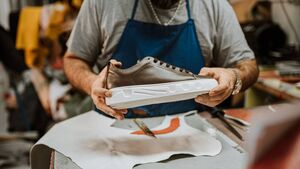Footwear could be leading to poor health

You wouldn’t buy a home with a poor foundation, nor would you buy a car with a damaged chassis. You should view your feet in the same light
THERE is a health crisis happening under your feet and it is getting worse and worse. It is causing substantial health issues for a large proportion of the population.
It is something that most people never think about but the footwear fashion industry has changed the design of their shoes and it is seriously undermining the health of a lot of people.
It is impacting on skeletal structure and biomechanics every day, denigrating both with the effect of you having more injuries and poorer health.
Your feet are the very foundation of your whole bodily structure. For most people, you spend hours on your feet day in and day out.
So whatever footwear you choose it only stands to reason that they are going to impact your health as they are having a direct impact on your very foundation.
You wouldn’t buy a home with a poor foundation, nor would you buy a car with a damaged chassis. You should view your feet in the same light as there is no difference really as these are your foundation on top of which everything else is built.
Why are these latest forms of training shoes causing this?
The first big issue is the elevated heel that is now adopted by most shoe brands. Now I am not referring to high heels when I speak about elevated heels, I am referring to the drop from the heel to the toe of the shoe.
It is the equivalent of a less obvious wedge that you see a lot of women wear on a social occasion. This phenomenon is not restricted to women's shoes; men’s shoes also have this heel-to-toe drop creating this wedge-like effect.
As a result of elevating the heel, we are directly influencing the structure of the rest of our body because we have changed the biomechanics of our body. The weight distribution of your body is altered as a result of this, and the load on your joints has been influenced and changed in a way that your body is not designed to cope with optimally.
It would be like sticking a wedge under one corner of your house, obviously, this is going to have an impact on the rest of the structure and change the load distribution throughout the remained of the structure.
On top of this the greater the increase in the size of the heel in comparison to the toe, the bigger the wedge. Your stride gets progressively shorter and shorter making you less athletic and forcing you to take more steps to cover the same ground in comparison to a barefoot person.
The second big issue is stiff soles that do not allow your feet to move and function in the way they were designed to do. Your feet contain 25 per cent of all the bones in your body so with this amount of bones, there is also a large amount of ligaments, tendons and muscles.
With these stiff soles, your feet are not able to perform the correct amount of dorsiflexion and plantar flexion as we locomote. When this happens our muscles, ligaments and tendons lose their strength and become limp as a result of the use it or lose it rule.
This results in an altered walking pattern and over time lot of foot issues such as plantar fasciitis, Morton’s neuroma, flat feet etc.
Thirdly, most shoes are not designed to accommodate your toes and have a narrow toe box which deforms your feet into an unnatural shape. Your toes are designed to splay and grip the ground as you walk, and you roll over your big toe as you step forward.
Modern shoes do not allow for this and a lot of people end up with clawed toes because the shoe is not designed to let the feet splay. This impacts the ligaments and tendons of our feet and also negatively impacts our gait pattern.
The fourth and final problem I am going to look into here is the thickness of the soles of the shoes, I see it time after time the thickness of the sole is getting bigger and bigger to the point where it is almost like running on a cloud.
Your foot is designed to give your body and brain feedback about the environment that you are in.
This is called proprioception but because of the thickness of the soles of these running shoes, our body is no longer able to give this feedback because it can’t feel the environment it is running on.
As a result of these thickened soles on the shoes we also have altered our running technique and now predominantly strike the ground with our heel forcing more and more ground forces through the joints of our body.
This is going to have a negative impact as these joints can experience two to three times your body weight while running.
So in the short term, my recommendation would be to slowly transition out of these wedged running shoes and into something that is flat and minimalist with a malleable sole that is easy to manipulate in your hands.
Start slowly and introduce them initially with walking and let your body get used to the new sensation and walking the way that your body is designed to walk but that has been forgotten through years of wrong footwear.
Retrain the musculature of your feet and legs, improving the mobility and stability of your feet and ankles.
Many barefoot brands are popping up now and it is becoming a lot more popular with design improvements and they are a lot more acceptable and fashionable now.






